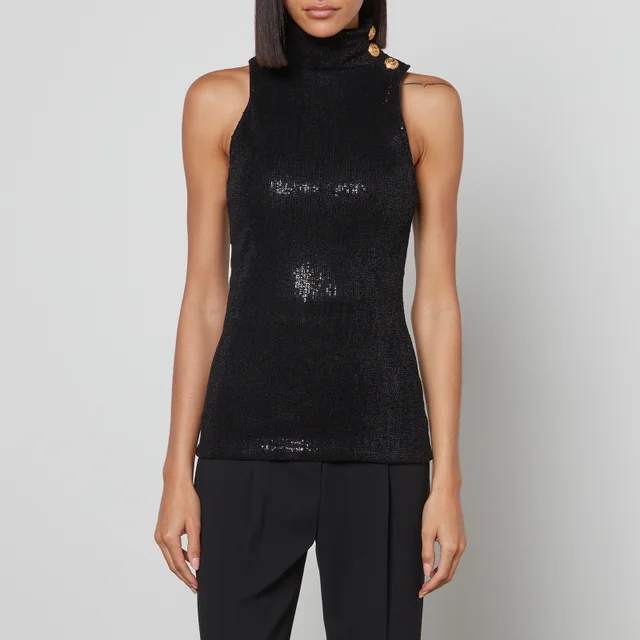Balmain is one of the longest-reigning fashion ateliers in the history of couture. Founded by Pierre Balmain, the luxury label has been adding to the fashion archives since 1945, revolutionising Paris couture alongside the likes of Christian Dior and Balenciaga. Feminine details, couture designs and bold fabrics all contribute to the brand's signature style, capturing attention across the globe.
At a time when utilitarian and regimented fashion was the norm, Pierre’s designs skyrocketed in popularity after glamorous Hollywood actresses such as Brigitte Bardot and Katharine Hepburn became transfixed with the brand in the 1950s. Join us as we take you on a guided tour through the Balmain history.Balmain's History
Pierre Balmain headed creative direction during the ’50s, the brand was largely considered an expert in couture, not ready-to-wear. When he opened the fashion house a year apart from his friend Christion Dior, it received glowing reviews, praising the combined ease and elegance of designs. That same year, it received special recognition in an issue of Vogue. Despite these early accomplishments, Pierre was adamant about pushing the boundaries of his design and dealings beyond the local sphere. Pierre Balmain
Travelling across to the US and Australia to build brand awareness, this innovative strategy at that time garnered Balmain brand status and won the loyalties of many Golden Hollywood celebrities. Big names such as Katherine Hepburn, Brigitte Bardot, and Ava Gardner donned Balmain gowns. Pierre remained at Balmain for the rest of his life, after his death, second-hand man Erik Mortensen took charge of the fashion house. During his time her maintained the integrity of Pierre’s original designs and tried to accommodate changing fashion trends. In 1993 Dominican designer Oscar de la Renta took over. With couture quickly falling out of style has had to change the fashion house with the times without losing the classic Balmain look. His collections for Balmain often mirrored that of his eponymous line, featuring feminine, ladylike silhouettes like low-hem fitted midi skirts, blazer jackets that cinched at the waist, and full skirts and gowns.
Christophe Decarnin for Balmain
It wasn’t until Christophe Decarnin took over as creative director in 2005 that Balmain took a turn toward more celebrity-led fashion. Features flashier styles, the inclusion of bright colours, and lots of leather — and became more provocative. But in 2011, Decarnin suddenly stepped down from his role to treat his battle with depression. This unfortunate event catapulted the young, bright-eyed Olivier Rousteing who had been working at the company into the limelight at the young age of 25.
Oliver Rousteign
After joining in 2009 from fellow luxury designer Roberto Cavalli, Olivier has encapsulated the label's legacy to fit today’s world of contemporary fashion. Heavily influenced by the label's rich archives, Balmain's designs embody classic Parisian style. When it comes to taking responsibility for a luxury fashion house with such heritage, it is important to evolve with the times in order to survive.

Collaborating with brands such as Victoria's Secret and H&M as well as maintaining a strong editorial and social presence, Olivier has made the brand accessible to all. Further to the brand's focus on collaborations with other influential labels, Balmain also has a diffusion line of their own, called Pierre Balmain. The collection features both men's and womenswear targeted at a younger customers with everything from Balmain T-shirts and jeans to tailoring and formal wear on offer. Reflecting the reputation of the brand in the 50s, modern-day Balmain is a favourite among musicians, actors and models. With strong collections in both menswear and womenswear, it's hard to escape the signature Balmain logo.
Olivier Routeing's Balmain Army
Something that Olivier wanted to do for the brand is push the boundaries of ethnicity. Being adopted, Rousteing has said that he used fashion to identify himself when growing up. When casting his 'Balmain Army' Olivier looks for personality and diversity, striving to bring more than just a face to his runways. Taking the role of Creative Director at the age of only 25, Olivier is part of the digital generation and therefore is fully aware of the importance of utilising the platforms available. With access to a hall of fame, Olivier Rousteing has brought the brand into the 21st century recruiting his A-list friends as brand ambassadors. Olivier has consequently grown his 'Balmain Army' into the exclusive group of influential talent that it is today. From fashion royalty Naomi Campbell and Cindy Crawford to the latest in new music Jorja Smith and Dua Lipa everybody wants to be a member of the Balmain Army. Olivier is truly the face of the label, in an interview with Vogue, Rousteing said that if he were to design an Olivier Rousteing collection it would essentially be Balmain. Initially branded the baby of Balmain now Balmain is his baby.Iconic 80's Influence
A child of the 80s, Olivier regularly uses influence from the decade in his collections, with his most recent collections featuring some tell-tale signs of the distinctive era in fashion. Not only do his designs feature structured shoulders, power suiting, shiny fabrics and oversized fits but his army is sent down the catwalk to 80's legends like Prince and The Supremes. Recognisable around the world for its 80s structure, double-breasted fit and metal button detail, the label is known for its iconic blazer. With its glamorous yet sophisticated silhouette, it has become an iconic blazer for ultimate power dressing.




















